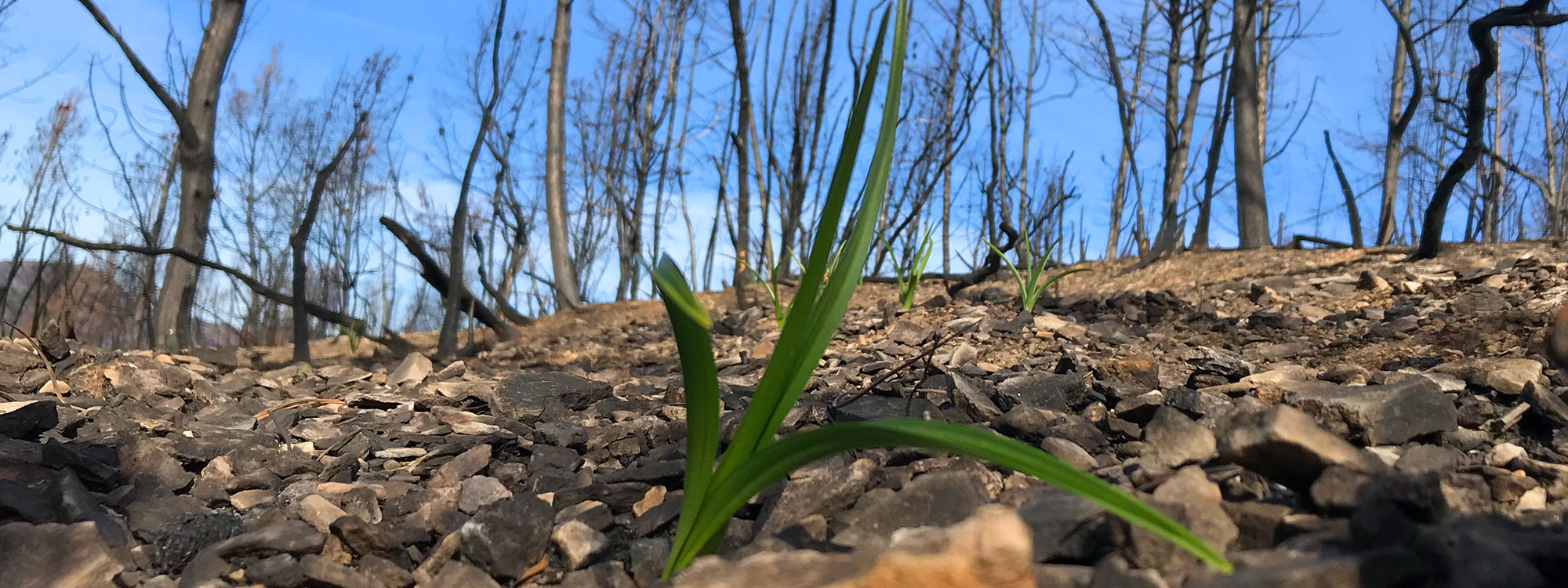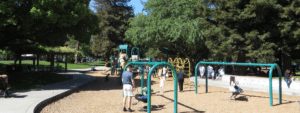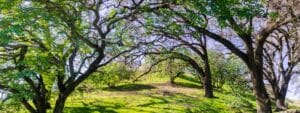On November 16th, Greenbelt Alliance staff members attended an event hosted by the Bay Area Open Space Council entitled “Gathering Together: A Community Discussion on the Impacts of the Recent Wildfires.” To lead off her talk, panelist Crystal Simons of the Sonoma Land Trust asked an audience of over 100 Bay Area residents, many from various conservation and planning organizations, to visualize and remember exactly where they were when they first found out the North Bay fires had started on the evening of Sunday, October 8th.
As the audience closed their eyes and returned to that unsettling moment, I recalled my own experience of sitting in my Vallejo apartment as the wind picked up and my windows began to rattle. I vividly remember the eeriness of the rattling and the fear when a strong smell of smoke filled the apartment hours later in the middle of the night.
Crystal’s question made me wonder if that Sunday evening and early Monday morning will be moments that those living in the Bay Area will never forget.
The Community Gathering served as a powerful healing and visioning process for local partners and Bay Area residents as we move forward in understanding the lessons learned from the recent North Bay wildfires. The morning conference featured speakers from Cal Fire, Sonoma County Agricultural Preservation and Open Space District, Sonoma Land Trust, Land Trust of Napa County, Sonoma County Regional Parks, California State Parks, Pepperwood Foundation, East Bay Regional Park District, and a fire ecologist from Audubon Canyon Ranch.
A Healing Process Begins
A focus of the panelists is the moment to moment work of healing from the devastation caused by the fires—the loss of life, homes, businesses, and livelihood. In Napa and Sonoma counties, there is a balance to be found between the important work of rebuilding and re-envisioning what many of the devastated areas will look like in years to come, but there is also the crucial work of grieving, coming together in community and solidarity, and processing the loss that has occurred.
Many of the panelists have been in personal and professional crisis and what they describe as “emergency mode” since October 8th. They’ve been tracking down, supporting, and ensuring the safety of family members, friends, colleagues, and acquaintances while also professionally dealing with the wildfires’ destruction—clearing debris from properties, assessing their managed lands, and working with partner organizations to understand the damage. Several of the panelists had to evacuate and knew of many who had lost their homes to the fire.
We here at Greenbelt Alliance are in awe of the resilience of our partners in Sonoma and Napa counties and look forward to continuing to support them in the long road of recovery ahead.
Lessons Learned from the Community Gathering
Lesson Learned #1: Recognize the Impact of Climate Change on the Wildfires
Wildfires in the American West may become our “new normal”, according to Cal Fire Staff Chief David Shew. Chief Shew said fire season in the West is now 70 days longer than it was 40 years ago and fire ignitions continue to increase above our normal 5-year average.
Due to global warming (an increase in average temperatures nationwide) and as a result of a recent 5-year drought in California, vegetation is dry and can catch fire easily. In the North Bay, fires on dry vegetation were further intensified by Category 1 hurricane winds that blew through the area on the evening the wildfires began.
Lesson Learned #2: Live in a “Firewise” Manner
According to fire ecologist Sasha Berleman of the Audubon Canyon Ranch, after over a century of practicing fire suppression policy, “California landscapes are in a dire fire deficit. Where fire has been long suppressed, we struggle with threatened human safety as tremendous wildfires become imminent in the face of accumulating fuel loads and lengthened fire seasons.” In 1909, there were, on average, 10-30 trees per acre in Napa and Sonoma counties. In 1990, there were 300 trees per acre, leaving much more “fuel source” for a wildfire.
Both Shew and Berleman say that we must learn to live with fire in a “firewise” manner. While traditional fire suppression policy may be an ongoing strategy in preventing wildfires moving forward, Berleman recommends that we must also think outside of the box by learning the land management practices of indigenous cultures to prevent wildfires.
More specifically, Berleman suggests we may be able to learn from Native Americans that lived in the Bay Area for thousands of years and effectively “utilized fire in California as a tool to manage landscapes for food, textile production, and improved wildlife habitat.” The Native Americans also had respect for the regenerative properties of nature should the land be scorched by wildfires. This regrowth is already being seen in small ways in Sonoma and Napa counties.
How can we live in a more “firewise” manner? Shew and Berleman suggest the following:
- Support fuel treatments like the grazing and browsing of animals, mechanical thinning, pile burning, and prescribed burning.
- Create “defensible space” around your home or property. This means regularly cleaning and clearing debris and vegetation around your home so it can’t catch on fire near your home.
- Educate yourself on good land-use planning practices. Think about which areas have traditionally been more prone to fires and may be prone to fires in the future.
Lesson #3: Preserving and Stewarding Open Space and Parklands Can Prevent Wildfires
Sonoma County Regional Parks Deputy Director Melanie Parker said that the Sonoma regional parks actually helped to prevent the wildfires from spreading into more residential areas as the parklands burned. They were able to dig large “dozer lines” (think of a 20-foot deep moat) in the parklands to prevent spreading. Outside of fire season, Parker noted that parklands can be learning labs for firefighters as they practice controlled burns within the parks. Regional park districts can also maintain healthy ecosystems within their parks by thinning vegetation and carrying out controlled burns.
The East Bay Regional Park District actually has a Fuels Management Plan through which they are consistently evaluating the “fuel sources” that start a wildfire. These fuel sources can be grass, brush, forest litter, and downed logs or branches. Their fire department works to remove these in crucial areas and also thins tree to reduce the potential for wildfires.
Lesson #4: Innovation and Forethought in the Rebuilding Process is Key
Santa Rosa alone lost 5% of its total housing stock in the fires. As we make decisions about how to rebuild, panelists noted that we must be strategic, innovative, and attuned to our rapidly changing climate. Bill Keene of the Sonoma County Agricultural and Preservation District noted the new SMART train that will eventually run between Cloverdale in Sonoma County and Larkspur Landing in Marin County. Keene highlighted the key potential of rebuilding homes near this public transit system.
On a very concrete level of rebuilding, Chief Shew said that 80-90% of the structures that ignited in the North Bay fires were because of embers spreading from the wildfires. As architects and contractors begin to think about building homes in potentially fire-prone areas, Chief Shew suggested using ember resistant building materials. Given the large cleanup effort of toxic materials from burnt cars and homes, multiple panelists suggested rebuilding with less toxic materials.
Lesson Learned #5: We can’t forget
As we’re both healing and planning for the future, East Bay Regional Park District General Manager Robert Doyle strongly cautioned the audience to not forget about the fires and the devastation they caused. This was a lesson learned from the Oakland Hills fire of 1991 which he lived through. He cautioned that while folks may be coming together in solidarity and collaboration right now, 5 to 10 years down the line, people can tend to forget about the fires and things could look very different. According to Doyle, we have to continue to “figure out ways to work out our differences without stopping progress”.
Taking a cue from Crystal Simons asking us to remember where we were and what we remember as the North Bay fires began, Greenbelt Alliance pledges not to forget the devastation of these fires and their impact on our region. We are thinking deeply about how these “lessons learned” can guide and inform regional policy in the years to come and we look forward to working with all of our partners throughout the North Bay, and specifically in Sonoma County, as recovery efforts continue.
Photo: California National Guard




